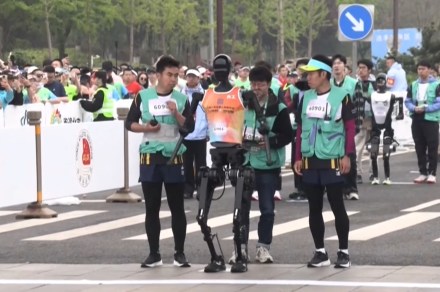Screenshot
France 24
You may have seen robots dancing like the music icon Mick Jagger, doing parkour, or even painting on a canvas. Tesla’s Optimus humanoid robot is eagerly anticipated, while Google and Meta are also planning to enter the field. The competition in the East, however, is on a different level altogether.
China just put humanoid robots to the test in the world’s first race of its kind, where they ran alongside humans in a half-marathon. A total of 21 robots lined up for the event in the Yizhuang half-marathon, following a long spell of supervised learning on roads.
The event saw a whole bunch of robotics companies showcase their ware. Some of the robots were as short as 3.9 feet, while others reach a typical human height of 5.9 feet. Some stumbled, a few tried to get back up on their own, while a small number needed human assistance.
During the race, the humanoid robots navigated around steep slopes, potholes, puddles, and smooth asphalt. Battery swaps were allowed, but replacement would incur a steep penalty. Not all robots made it to the finish line, however, despite intervention by robotics and software experts.
Did robots beat humans?
Not really, and the gap was huge, as well. The human victor finished the half-marathon in just over an hour, while the winning humanoid robot took 2 hours and 40 minutes to reach the finish line.
That comes down to an average speed of 4.89 miles per hour. For comparison, Olympic champion Usain Bolt reached a top speed of 27.33 miles per hour at a track event in 2011. Beating a human runner, however, was never the point, even though the winner outperformed the engineering team’s expectations by roughly half an hour.
The half-marathon in China was more like a showcase of progress made by local robotics companies. The winner among the humanoid robots, named Tiangong Ultra, is developed by the Beijing Innovation Center of Human Robotics.
A milestone achievement
“I don’t want to boast but I think no other robotics firms in the West have matched Tiangong’s sporting achievements,” Tang Jian, head of the company behind the winning robot, was quoted as saying by Reuters.
It’s a state-backed company in which Chinese electronics giant Xiaomi is also a key stakeholder. According to SCMP, the company aims to become “the Android in the field of humanoid robots.” For the half-marathon, some modification work was also done to get the best performance.
“We lightened the robot without compromising its strength, refined its leg design, and improved its thermal conductivity and air-cooling systems to boost stability and endurance,” Guo Yijie, a technician for the Tien Kung Ultra robot, told Xinhua.
Participating companies and the organizers behind the unique half marathon note that the ultimate goal is to showcase humanoid robots in human environments. They will soon graduate from design labs to industrial settings, but the ultimate goal is to put them into an average person’s home as a helpful assistant.
Nadeem is a tech and science journalist who started reading about cool smartphone tech out of curiosity and soon started…
Cadillac offers first glimpse of upcoming Optiq-V performance EV
Cadillac has released the first official teaser images of the 2026 Optiq-V, offering a preview of the brand’s second all-electric model to join the performance-focused V-Series lineup. The images, which highlight subtle styling upgrades, mark the first confirmation of the new variant ahead of its full reveal later this year.
The Optiq-V builds on the foundation of the standard Optiq, Cadillac’s compact electric SUV introduced for the 2025 model year. According to the automaker, this V-Series version will feature a more dynamic driving experience, with enhancements to steering, suspension, and overall agility. While technical details remain limited, Cadillac’s press release emphasizes that the Optiq-V was engineered for “precision” and an “exhilarating” feel behind the wheel.
Reports from CarScoops suggest the Optiq-V could produce up to 515 horsepower through a dual-motor all-wheel-drive system, significantly surpassing the 300 horsepower of the base model. Teaser images reveal a diamond-pattern mesh grille, V-Series badging, and a rear spoiler — all nods to its performance orientation. Photos also hint at additional visual updates, such as redesigned bumpers, 21-inch wheels, and larger brakes.
The base Optiq, reviewed recently by Digital Trends, is positioned as Cadillac’s entry-level EV and shares its underpinnings with the Chevrolet Equinox EV. Despite that connection, the Optiq features premium materials, a curved 33-inch display, Google built-in tech, and standard dual-motor all-wheel drive. While the review noted some drawbacks in steering feel and performance tuning, it praised the vehicle’s cabin quality and overall comfort.
The Optiq-V is expected to retain the standard model’s 85-kWh battery and roughly 300-mile range, though final figures have yet to be announced. Cadillac says more details on specs and pricing will be available closer to the model’s official launch.
With the addition of the Optiq-V, Cadillac continues expanding its electric lineup while reinforcing its V-Series as a key part of its identity — now in the EV era.
Read more
Nissan delays price increases until June amid U.S. tariffs
Nissan buyers, take note: if you’re eyeing a new ride, you might want to make your move before summer. The automaker has announced it won’t raise prices on imported vehicles until at least June 2, giving car shoppers a brief reprieve from the impact of the new 25% U.S. import tariffs.
According to a memo sent to U.S. dealers and reported by Automotive News, Nissan is able to hold prices steady thanks to a stockpile of tariff-free vehicles—enough to last nearly three months. But once that inventory runs dry? Prices are likely heading north. Nissan’s U.S. sales chief Vinay Shahani assured dealers that the company is working to “minimize the impact” of tariffs on customers, but he was also frank: “There will be an impact.”
To soften the blow, Nissan is ramping up production at its U.S. plants in Smyrna, Tennessee, and Canton, Mississippi. Those factories were only running at about half capacity last year, so there’s plenty of room to grow. The Rogue—Nissan’s best-seller—will get a second shift on its assembly line, increasing production by about 60,000 vehicles. Other models like the Pathfinder, Frontier, and Murano will also see higher domestic output.
The goal? Build more cars stateside and dodge the tariff altogether.
Nissan’s move puts it in line with other automakers holding the line on prices—at least for now. Hyundai, Toyota, and Honda have made similar pledges, while rivals like Ford and Stellantis are rolling out temporary discounts to ease the pain.
As Digital Trends noted, Nissan’s decision comes as it rethinks its production and pricing strategy in the face of shifting trade policies and a nervous market. With high-volume imports like the Sentra and Ariya still coming from Mexico and Japan, this pricing grace period might not last long.
Read more
Buick, Audi, and Nissan score top marks in latest IIHS safety ratings
The Insurance Institute for Highway Safety (IIHS) has added four more vehicles to its coveted 2025 Top Safety Pick and Top Safety Pick+ lists. If you appreciate knowing your vehicle is built with safety in mind, this update is worth noting.
Among the standout performers: the Audi Q6 e-tron, Buick Enclave, and Nissan Armada—each earning the institute’s highest honor, the Top Safety Pick+ award. The GMC Acadia also made the grade, picking up a Top Safety Pick award. For Buick and GMC, these honors mark a significant return to form, as neither brand had received IIHS awards in several years. In fact, it’s the first time since 2013 that the Enclave has been recognized.
So, how does IIHS hand out these awards? Picture a battery of tests that simulate real-world crashes—everything from small overlap front impacts to updated side crashes. To make the list, vehicles must ace (i.e., earn a “good” rating in) key crashworthiness tests, show competence in pedestrian crash prevention, and offer headlights that don’t blind oncoming drivers. For the higher-tier Top Safety Pick+, there’s an extra hurdle: a “good” rating in the updated moderate front overlap test, which now factors in rear-seat passenger protection.
Improvements to the Enclave and Acadia’s headlights, introduced after January 2025, helped push them over the finish line. Unfortunately, not all models in this testing round were so lucky. The Cadillac Lyriq, Audi Q6 Sportback e-tron, Kia K4, and several Nissan models—including the Kicks, Rogue, and Sentra—fell short. Common issues? Poor headlight performance or incomplete testing.
The IIHS notes that these evaluations are ongoing. Not every vehicle released for 2025 has been fully assessed, and late-year updates can still improve a model’s score. For the full list of safety awards, you can check out the IIHS website.
Read more











